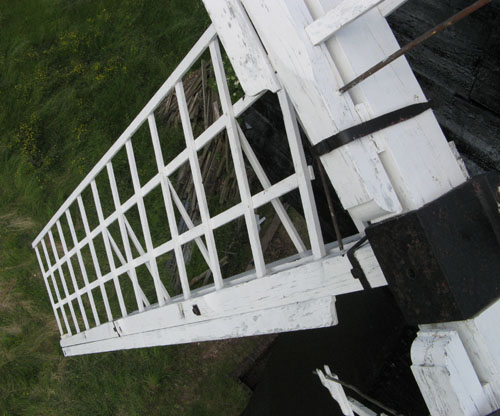
A close look at the paintwork on the sails, taken in 2008.

A close look at the paintwork on the sails, taken in 2008.
The sails had not been painted for quite a few years, when Geoff would resolutely tackle them on his own. We had decided that a concerted effort should be made to get them all painted, but as always, the question was when, as a fine spell of weather would be needed. We needed to have equipment to access the sails for a number of days, which would normally involve considerable cost, but it is always worrying to think of it standing idle in wet weather, and still having to be paid for.
We were very lucky to be offered the use of an electrically-operated cherry-picker which could be left on site for us to use as we could. This was too good an offer to miss, so we rapidly purchased the paint and other materials required. By Thursday 14th August it looked as though a settled spell of weather could be approaching, so on the Thursday and Friday I manually turned the cap so that the sails were facing north. The work had to be done on that side where we have the most space for the cherry-picker to be sited. We also wanted to concentrate all the inevitable white paint splashes on one wall of the windmill.
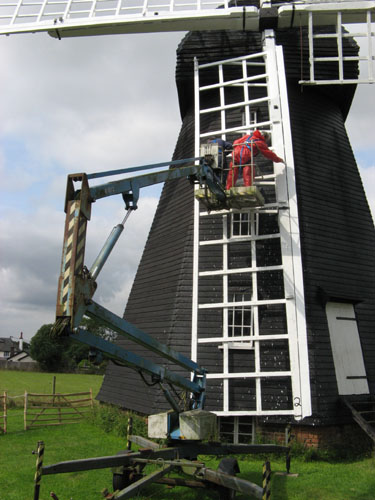
On Saturday the cherry-picker was set up in position, and painting work was started on Sunday. It was obviously necessary to do some preparation work, but wire brushing proved adequate to remove any loose paint and also any algae, which tends to be on the back of the sails, a part always given some protection from the wind, and therefore prone to staying damp in the winter months. Each sail was turned to be vertical in front of the mill for its treatment.
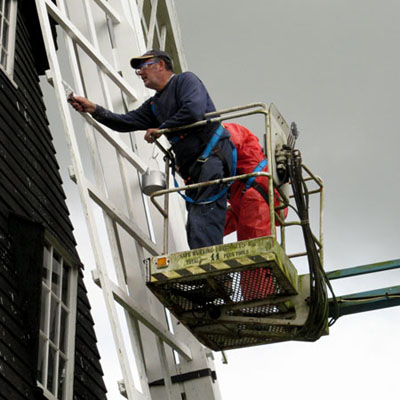
Chris
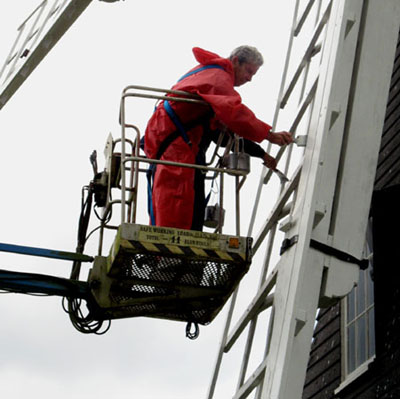
David
The only rain that week was on the Wednesday, so work continued every other day and with the help of 5 volunteers at different times, the painting of the sails was completed on Saturday 22nd August.
With the cherry-picker we could reach the front of each sail and round to the leading edge of each sail, including one side of the stocks and the whips. However there are parts of the back of the stocks that can only be seen and reached from doors in the front of the cap that are above the canister that holds the stocks. Geoff painted these parts through the open doors. All this needs a lot of precise turning of the sails to be able to open the doors and reach as much of each stock as possible.
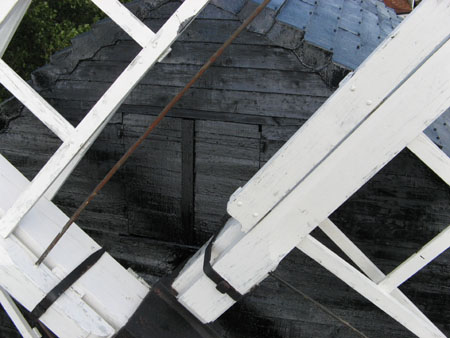
The hatch in the front of the cap through which the back of the centre of the stocks can be reached.
It was also difficult to reach the trailing side of the stocks from the cherry-picker situated in front of the sails. Therefore on Saturday 22nd August, I turned the cap around to face the east and we used the cherry-picker to access all the parts on the back of the sails that had been missed, or could not be seen and reached from the front.
Obviously the use of 15 litres of white paint just in front of a black windmill results in a lot of white splashes on the black body of the windmill. Therefore, whilst we still had the use of the cherry-picker, I spent Sunday 23rd August re-tarring all the parts of the windmill which had become splashed with white paint, including the whole of one wall.
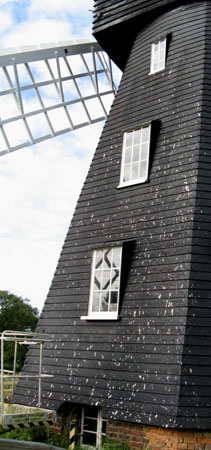
The splashed wall that needed re-tarring.
Our volunteers who painted the sails were Chris, Geoff, David, John and myself (Michael Hardy). We are grateful to them all for their hard work, and we are also very grateful to another Michael who kindly lent us the cherry-picker which enabled us to do the work at minimal cost, which was very welcome.
The photo below shows the windmill a few days after the painting of the sails was completed.
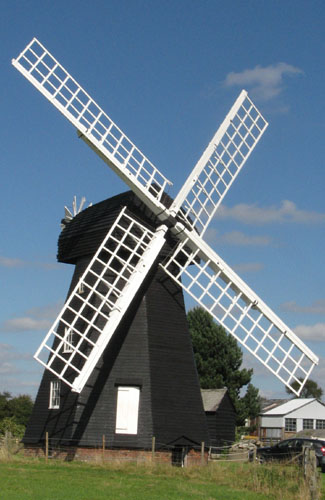
This page ( painting-2009.php ) was last updated on 7 February 2018.
The Chiltern Society is a Registered Charity No 1085163 and a Company Limited by Guarantee Registered in England and Wales Registration No 4138448.